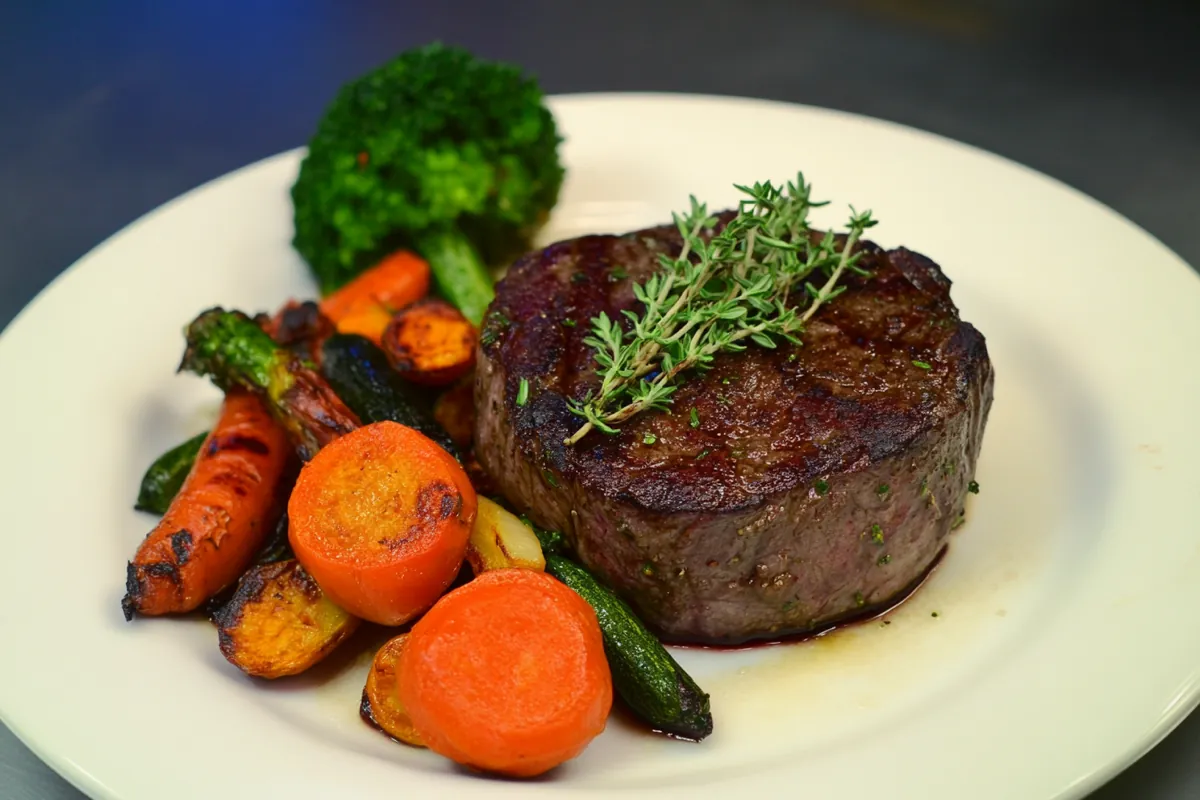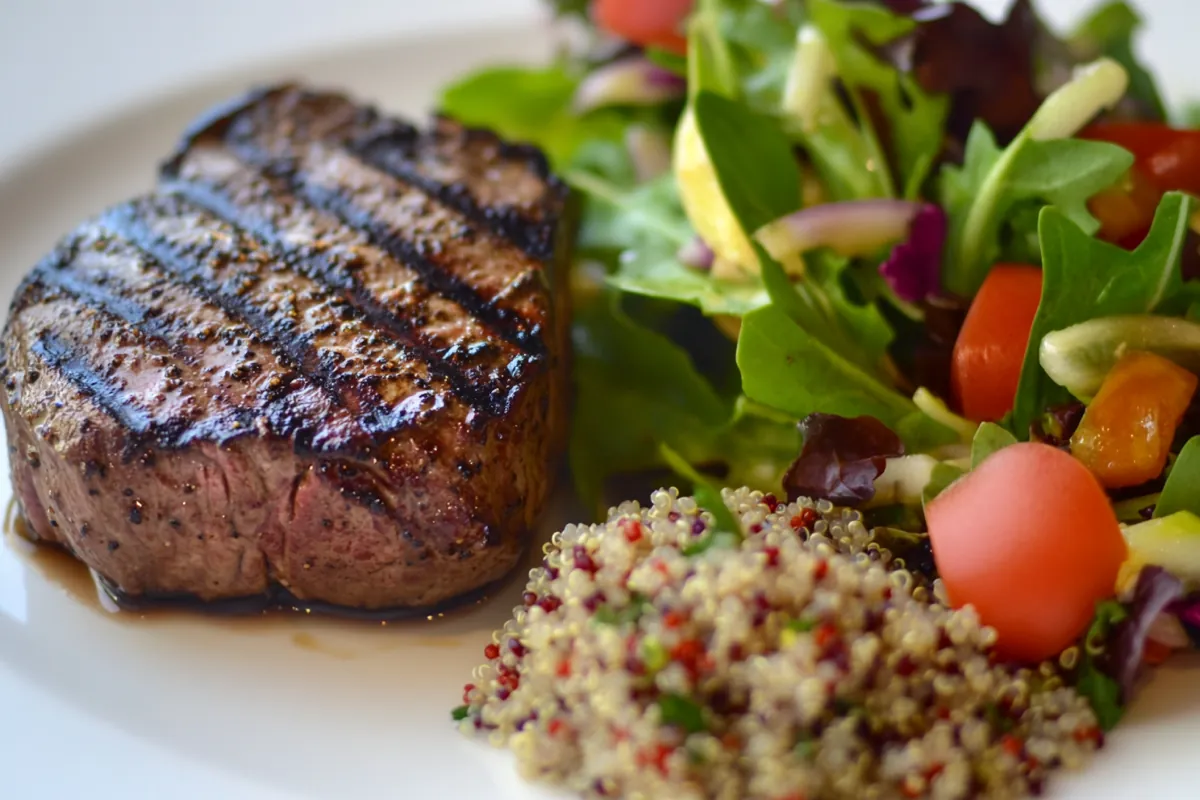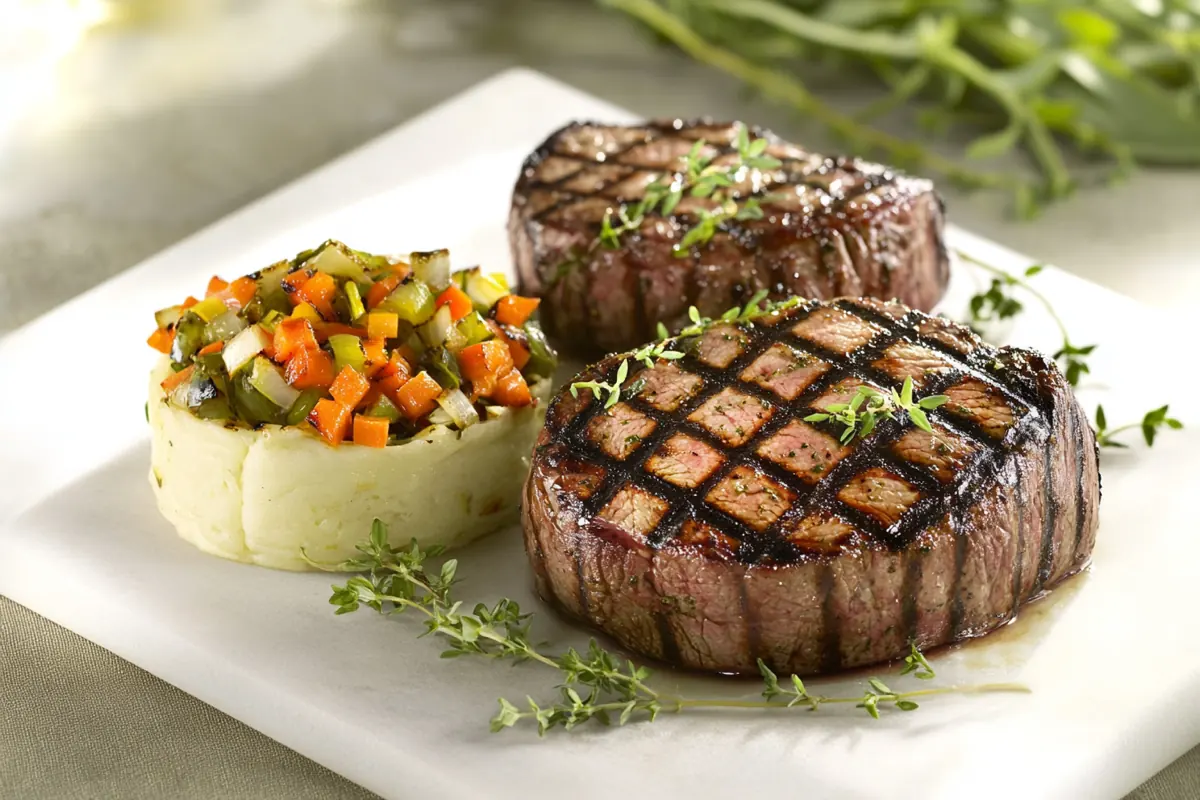Filet mignon is a favorite among steak enthusiasts. Known for its tender texture and rich flavor, it’s often sought after for special occasions. However, understanding the calories in filet mignon is essential for those watching their diet. In this article, we’ll explore everything you need to know about this delicious cut, including its nutritional profile and how to enjoy it guilt-free.
Table of contents
Introduction to Filet Mignon
Filet mignon is cut from the tenderloin of the beef. This area is less exercised, which is why it’s so tender. Many people appreciate this cut for its buttery texture and mild flavor. It’s often served in high-end restaurants and is a popular choice for celebrations.
What is Filet Mignon?
Filet mignon is a French term meaning “dainty fillet.” It has become synonymous with luxury dining. This steak is prized not only for its tenderness but also for its versatility in cooking. You can grill, pan-sear, or roast it to perfection.
Nutritional Overview of Filet Mignon
When it comes to nutrition, filet mignon offers a good source of protein, making it an excellent choice for muscle repair and growth. A typical serving also contains essential vitamins and minerals, including:
- Iron: Important for blood health.
- Zinc: Vital for immune function.
- Vitamin B12: Necessary for nerve health and energy production.
Understanding the calories in filet mignon can help you incorporate it into a balanced diet while satisfying your cravings.
Calories in Filet Mignon Per Ounce
Now let’s take a closer look at the calories in filet mignon per ounce. Knowing this can help you make informed choices when dining out or preparing meals at home.
Breakdown of Calories in Filet Mignon Per Ounce
On average, filet mignon contains about 42 to 50 calories per ounce when cooked. This number can vary slightly based on cooking methods and preparation.
Raw vs. Cooked: How Preparation Affects Calories
The calorie content of filet mignon changes depending on its preparation. For instance, raw filet mignon has fewer calories than when it is cooked. Cooking often adds fats like butter or oil, increasing the overall calorie count.
Comparison with Other Cuts of Beef
When compared to other cuts of beef, filet mignon is relatively low in calories. For example, ribeye steak can contain over 70 calories per ounce due to its higher fat content. This makes filet mignon a more favorable option for those seeking to lower their calorie intake while still enjoying red meat.
Calories in Filet Mignon: 8 oz and 12 oz Portions
Portion sizes significantly affect the total calorie count of your meal. Let’s explore the filet mignon calories in common serving sizes.
Calories in Filet Mignon in an 8 oz Serving
An 8 oz serving of cooked filet mignon typically contains about 336 to 400 calories. This can vary depending on how it’s cooked. For example, grilling may add fewer calories than pan-searing with butter.
Cooking Methods and Their Impact on Calories
Different cooking methods can change the calorie count. For instance:
- Grilling: Minimal added calories if no butter is used.
- Pan-Searing: Can add more calories due to oil or butter.
- Roasting: Generally similar to grilling if done without excess fat.
12 oz Filet Mignon Calories: What to Expect
If you opt for a larger portion, such as a 12 oz filet mignon, you can expect about 504 to 600 calories. Again, the cooking method will influence this number.
Serving Sizes and Portion Control
Understanding portion sizes is crucial. It’s easy to overindulge, especially with delicious cuts like filet mignon. To maintain a balanced diet, consider using measuring tools or visual cues to gauge serving sizes accurately.

Health Benefits of Filet Mignon
Filet mignon is more than just a delicious cut of meat; it also offers several health benefits. While enjoying this luxurious steak, it’s essential to understand its nutritional profile to make informed dietary choices.
Protein Content and Its Importance
One of the standout features of filet mignon is its high protein content. A typical 8 oz serving contains approximately 56 grams of protein. Protein plays a crucial role in:
- Muscle repair and growth: Essential for athletes and active individuals.
- Hormone production: Helps in maintaining bodily functions.
- Immune function: Aids in the production of antibodies.
For those looking to maintain or build muscle, filet mignon is an excellent source of quality protein.
Vitamins and Minerals Found in Filet Mignon
In addition to protein, filet mignon is rich in essential vitamins and minerals. Some key nutrients include:
- Iron: Vital for transporting oxygen in the blood.
- Zinc: Supports immune health and wound healing.
- Vitamin B12: Important for nerve function and energy metabolism.
Including filet mignon in your diet can help you meet your nutritional needs while enjoying a tasty meal.
Filet Mignon and Dietary Considerations
While filet mignon is a nutritious option, it’s essential to consider how it fits into your overall dietary plan.
Is Filet Mignon Bad for Cholesterol?
Many people wonder if filet mignon is bad for cholesterol. The answer is not straightforward. While red meat can contain saturated fats, the impact on cholesterol levels varies among individuals.
Understanding Saturated Fats in Filet Mignon
Filet mignon does contain saturated fat, but in moderation, it can fit into a healthy diet. Research suggests that not all saturated fats impact cholesterol levels equally. Therefore, enjoying filet mignon occasionally should not pose a significant risk for most individuals.
Balancing Filet Mignon with Other Nutrients
To enjoy filet mignon healthily, balance it with other nutrient-rich foods. Here are some tips:
- Pair with Vegetables: Add a side of steamed or roasted vegetables to enhance fiber and nutrient intake.
- Whole Grains: Serve with whole grains like quinoa or brown rice for added health benefits.
- Healthy Fats: Use heart-healthy oils, such as olive oil, for cooking or dressing.
By balancing filet mignon with diverse food groups, you can create a satisfying and nutritious meal.
Tips for Enjoying Filet Mignon Without Guilt
Indulging in filet mignon doesn’t have to lead to guilt. Here are some practical tips to enjoy this delicious cut while maintaining a balanced diet.
Portion Control and Serving Suggestions
To enjoy filet mignon without overindulging, practice portion control. Here are some effective strategies:
- Use a Scale: Weigh your steak to ensure accurate serving sizes.
- Visual Cues: A serving size of meat should be about the size of your palm.
- Limit Frequency: Enjoy filet mignon as an occasional treat rather than a regular meal.
Pairing Filet Mignon with Healthier Sides
Choosing the right sides can enhance your meal’s nutritional value. Consider these options:
- Salads: A fresh salad can add fiber and nutrients.
- Roasted Vegetables: Colorful vegetables provide vitamins and antioxidants.
- Quinoa or Brown Rice: Whole grains can help round out your meal with healthy carbs.
Cooking Methods: Healthier Choices
The way you prepare filet mignon can impact its overall healthiness. Here are some healthier cooking methods:
- Grilling: Allows excess fat to drip away while adding flavor.
- Baking: A healthier option that requires little added fat.
- Sous Vide: This method retains moisture without adding extra calories.
By implementing these tips, you can savor the flavors of filet mignon while keeping your diet in check.

Common Misconceptions About Filet Mignon
Despite its popularity, there are several misconceptions about filet mignon that can lead to confusion. Let’s clear up some myths surrounding this delightful cut of beef.
Myths about Red Meat and Health
One common misconception is that all red meat is unhealthy. While excessive consumption of red meat can be detrimental, moderate intake, especially of lean cuts like filet mignon, can fit well into a healthy diet.
The Truth About Fat Content in Filet Mignon
Another myth is that filet mignon is excessively fatty. While it contains some fat, it is relatively low compared to other cuts like ribeye. Understanding the actual fat content can help you make informed decisions about your meal choices.

Recipes Featuring Filet Mignon
If you’re looking to enjoy filet mignon in a delicious way, consider trying out some gourmet recipes. Here are two tasty options to elevate your dining experience.
Grilled Filet Mignon with Garlic Butter
Ingredients:
- 2 filet mignon steaks (6 oz each)
- 2 tablespoons olive oil
- 2 tablespoons unsalted butter
- 2 cloves garlic, minced
- Salt and pepper to taste
- Fresh herbs (rosemary or thyme) for garnish
Instructions:
- Preheat your grill to high heat.
- Brush the steaks with olive oil and season with salt and pepper.
- Grill the steaks for about 4-5 minutes on each side for medium-rare.
- In a small saucepan, melt butter over low heat and add minced garlic.
- Remove the steaks from the grill and drizzle with garlic butter.
- Garnish with fresh herbs and serve with your choice of sides.
Pan-Seared Filet Mignon with Mushroom Sauce
Ingredients:
- 2 filet mignon steaks (8 oz each)
- 1 tablespoon olive oil
- 1 cup mushrooms, sliced
- 1/2 cup beef broth
- 1 tablespoon Worcestershire sauce
- 1 tablespoon Dijon mustard
- Salt and pepper to taste
Instructions:
- Heat olive oil in a skillet over medium-high heat.
- Season the steaks with salt and pepper and sear for 4-5 minutes on each side for medium-rare.
- Remove the steaks and let them rest.
- In the same skillet, add sliced mushrooms and cook until browned.
- Stir in beef broth, Worcestershire sauce, and Dijon mustard; simmer until slightly thickened.
- Serve the steaks topped with the mushroom sauce.
Understanding Serving Sizes and Their Impact on Calories
Being aware of serving sizes can help you manage your calorie intake effectively. Here’s a quick guide to visualize portion sizes.
Visualizing Portion Sizes: 4 oz, 8 oz, and 12 oz
- 4 oz Serving: About the size of a deck of cards. This is a reasonable portion for a lighter meal.
- 8 oz Serving: Comparable to a smartphone. This is a standard steak portion for a satisfying meal.
- 12 oz Serving: Roughly the size of a large bowl. This is often too much for one sitting and can be saved for later.
Practical Tips for Measuring Filet Mignon
To ensure you’re serving the right portion, consider these tips:
- Use a Kitchen Scale: Accurately measure your steak for precise serving sizes.
- Visual Comparisons: Familiarize yourself with common objects to gauge portion sizes easily.
- Pre-Portion: Cut larger steaks into smaller portions before cooking to help control servings.
The Cost of Filet Mignon: Is It Worth the Calories?
When considering whether to indulge in filet mignon, it’s essential to weigh the cost against its nutritional value and satisfaction.
Comparing Price and Nutritional Value
Filet mignon is typically more expensive than other cuts of beef. However, its unique flavor and tenderness can make it worth the splurge. Additionally, the nutritional benefits it offers, such as high protein and essential vitamins, add value to your meal.
Budget-Friendly Alternatives to Filet Mignon
If filet mignon stretches your budget, consider these alternatives that still provide a delicious experience:
- Sirloin Steak: Leaner and more affordable while still flavorful.
- Beef Tenderloin: Slightly less tender than filet mignon but offers great taste.
- Flank Steak: A flavorful option that can be marinated to enhance tenderness.
By understanding your options, you can enjoy steak dinners without breaking the bank.
Conclusion: Making Informed Choices
In conclusion, understanding the calories in filet mignon and its nutritional benefits can enhance your dining experience. By being mindful of portion sizes and cooking methods, you can enjoy this tender cut without compromising your health goals.
Summary of Key Points
- Filet mignon is a rich source of protein, vitamins, and minerals.
- It typically contains 42 to 50 calories per ounce, with variations based on cooking methods.
- Enjoying filet mignon in moderation, along with a balanced diet, can be part of a healthy lifestyle.
Encouraging a Balanced Approach to Eating
When enjoying filet mignon, remember to balance indulgence with health. Pair it with nutritious sides and practice portion control to make the most of this delightful cut. By doing so, you can savor the flavors of filet mignon while maintaining a healthy relationship with food.
FAQ
As filet mignon garners interest, many people have questions about its nutritional value and health implications. Here are some commonly asked questions to clarify any uncertainties.
How Many Calories are in 8 oz of Grilled Beef Tenderloin?
An 8 oz serving of grilled beef tenderloin, which includes filet mignon, typically contains around 336 to 400 calories. The cooking method can slightly alter the calorie count, so it’s essential to consider how it’s prepared.
How Many Calories are in a 4 Ounce Cooked Beef Tenderloin?
A 4 oz serving of cooked beef tenderloin has approximately 168 to 200 calories. This makes it a great option for those looking to enjoy a flavorful cut of meat while managing their calorie intake.
Is Beef Tenderloin Bad for Cholesterol?
Like many cuts of red meat, beef tenderloin, including filet mignon, contains saturated fat. While some may worry about cholesterol levels, moderate consumption is generally acceptable for most people. It’s crucial to balance your diet with fruits, vegetables, and whole grains to support heart health.




